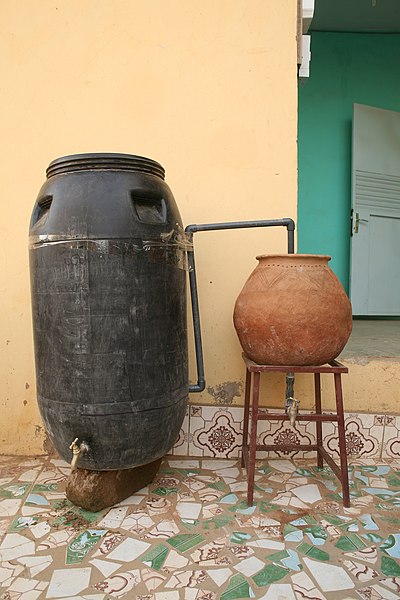Detail from 'Fish in Water' Stepping Stone
Now that I'm happy with my prototype system, let me lay out an incremental approach for building a aquaponics system based on Rubbermaid stock tanks. All you'll need is a drill with a 1 inch bit, a shovel, a level, and a saw. No solvents, no grinders, no silicon, no sanding. All the stuff you'll need should be available locally, though you might need to pay S&H for certain items if you're not in a metropolitan area.
1 - Basic system (3 ft. x 8 ft., $350)
Your basic system will be a single 50 gallon grow bed and a 100 gallon fish tank. Because you're not yet sure you really want to do this, go ahead and use 3/4" river stone for your growing medium. Pick up a handful of feeder goldfish or better yet bluegill, if they're available. If you're thinking of evolving this into a bigger system, you'll want to position things so you won't have to move as you expand. If you and those you love know this will be it, you can stack the grow bed on top of the fish tank for the classic 3x5 footprint.
You might as well prepare for success by buying all the little
odds and ends needed to test your water, 'cycle' your smallish system, and adjust water quality.
2 - Add a grow bed (+$300)
Things have been going great, and your nitrate levels are starting to get pretty intense. At this point you'll want to add another 50 gallon growbed (with supporting blocks and planks). Now is also the time to upgrade to the big pump. A 1000 gph pump doesn't cost much more than the little thing you bought for your initial system. This is also the time to switch from that flimsy black tubing to serious no-kink lead-free garden hose.
3 - Add a 150 gallon CHOP fish tank, kiddie covers, and a shelter (+$300)
You know you hate how the fish tank water level fluctuates, not to mention the way the water level dips due to evaporation when you forget to check for days (weeks) at a time. Besides, there's the time you found the cute little person wading in the fish pond, trying to catch the fish with their hands... Now's also a good time to lay out the foundation and 'hoops' for your greenhouse and at least enough plastic sheeting to keep the rain off you and keep all those tree seeds out of your grow beds.
4 - Add grow beds 3 & 4 (+$300)
The nitrate is getting intense again - must be the way those fish are exploding now that they have a safe, constant water space to swim around in. It's also a good time to finish off the rest of the greenhouse, now that you've found chunks of plants missing (was it a hungry squirrel, raccoon, or neighbor...?).
5 - Let your imagination take you
You might want to add a floating raft bed for fast-growing vegetables, or add grow towers for strawberries and herbs. These details will be dictated by your interest and space constraints.
__________________________
Based on today's prices at chain stores, total cost for the 40 sqft growbed system, including greenhouse, fish, and media, should come in at under $1250, assuming one goes for the inexpensive options (e.g., growing own plants from seeds versus getting semi-mature plants from nurseries, locally sourced river stones versus S&H and cost for expanded shale or hydroton).
Compare how much it will cost to do this versus other systems, making sure you compare apples to apples (most kit prices don't include media, fish, or things like pumps and cinder blocks, etc.). You might be able to create a cheaper DIY system from intermediate bulk containers (IBCs) or 55-gallon drums, but you'll likely spend more time and effort.
Here's a reasonable budget for each part of the total system:
- Rubbermaid stock tanks - $480
- Cinderblocks & planks - $60
- Kiddie covers - $30
- Pump, hose, & fittings - $140
- 4 Bell siphons - $40
- CHOP plumbing - $15
- Air Pumps, tubing, & air stones - $60
- Media - $50 to $500 (depending on type and if available locally).
- Fish - $40 (50 bluegill for ~$0.60 each [3-5" size])
- Seeds - $10
- Extras (Seasol/Maxicrop, ammonia, water test kit, pH up and/or down) - $100
- 8 ft. x 12 ft. Greenhouse - $200













































